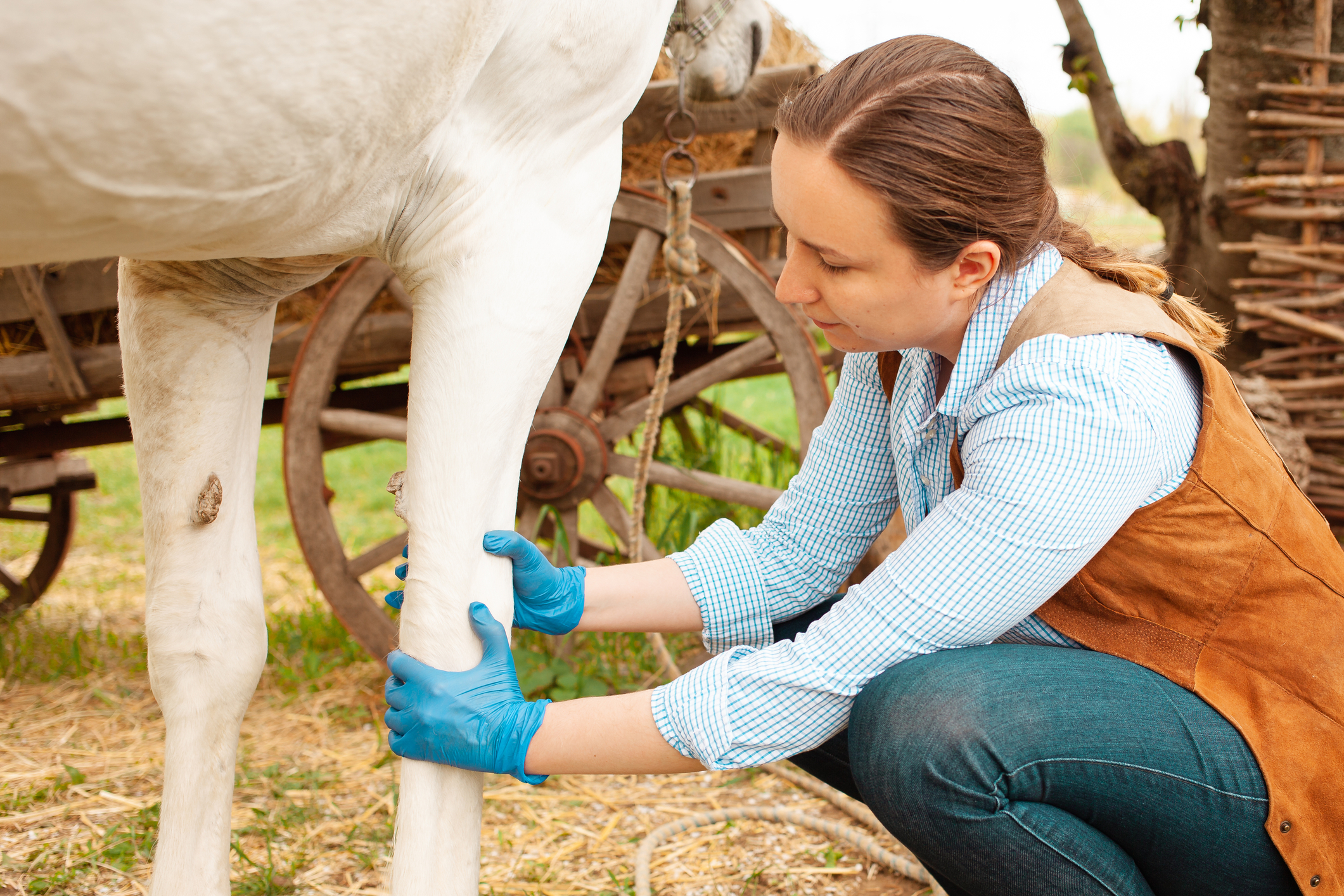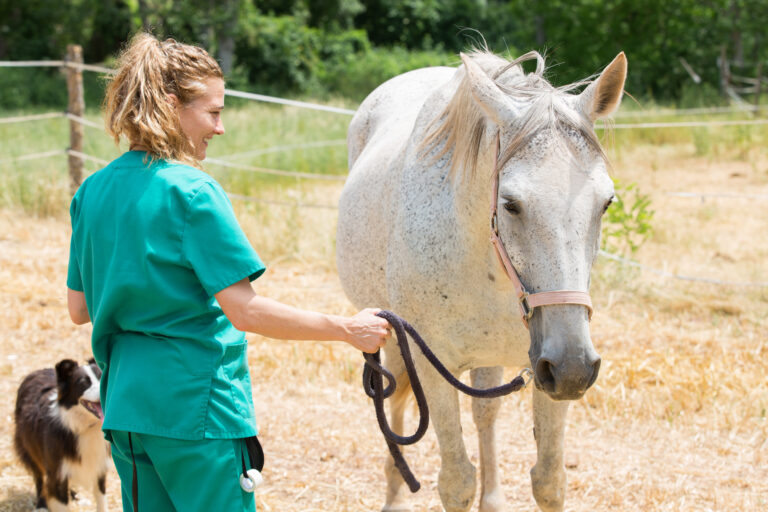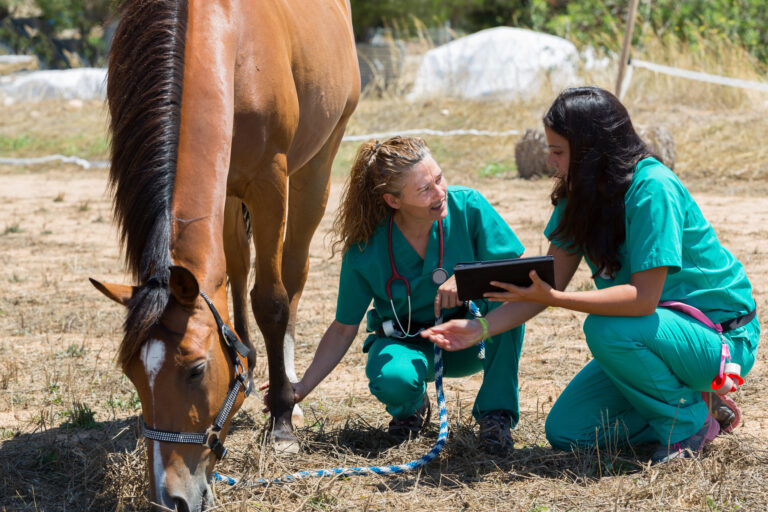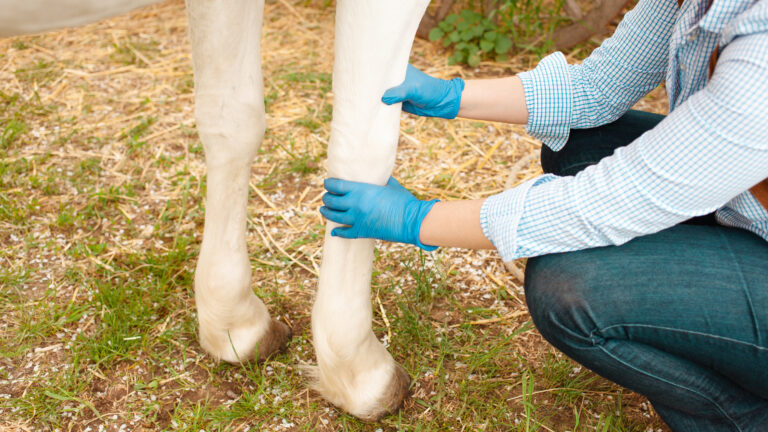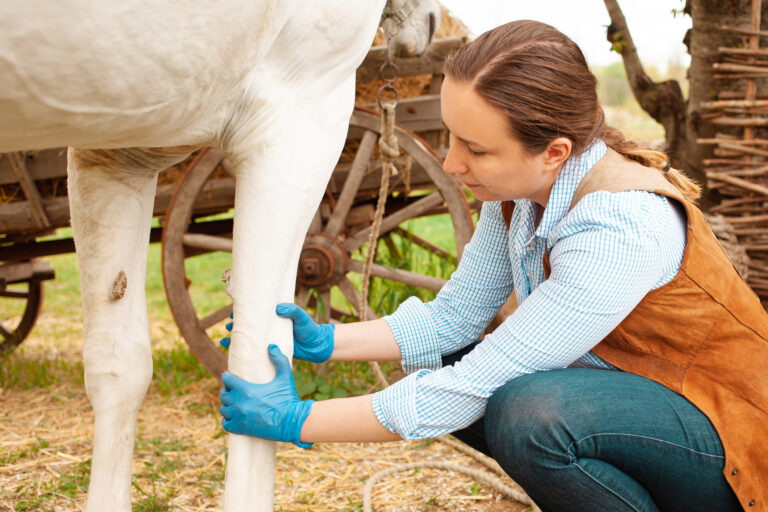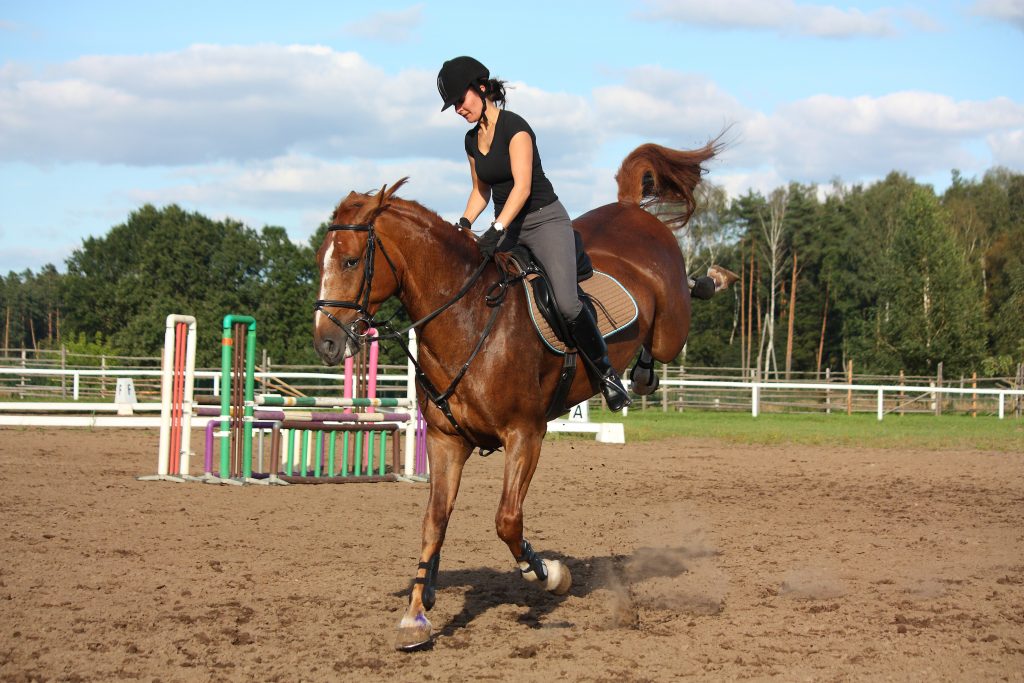Lameness in the Front Legs: Common Issues and What They Mean
As equine veterinary professionals, we understand that front leg lameness is one of the most common and concerning issues horse owners face. At Stride Vets, we frequently encounter horses with forelimb lameness, and early recognition and proper diagnosis are crucial for successful treatment outcomes. In this comprehensive guide, we’ll explore the most common causes of front leg lameness, their clinical signs, and what they mean for your horse’s health and performance.
Understanding Front Leg Lameness
Lameness is defined as an abnormal stance or gait caused by either a structural or functional disorder of the locomotor system. When it comes to front leg lameness, approximately 90% of cases arise from problems in the lower limb, below the fetlock joint. This makes the foot and lower leg structures the primary areas of concern for veterinary examination.

Key fact: Front leg lameness presents with characteristic head nodding – when the lame leg hits the ground, the horse lifts its head to reduce weight-bearing on the affected limb.
The Most Common Causes of Front Leg Lameness
1. Hoof Abscesses
Foot abscesses are the most common cause of lameness in horses. These bacterial infections occur when microorganisms enter through small cracks in the hoof, often due to exposure to mud, manure, and challenging environmental conditions.
Clinical Signs:
- Sudden onset severe lameness
- Increased digital pulse
- Heat in the hoof
- Reluctance to bear weight
- Possible swelling around the coronet
What it means: While abscesses can be extremely painful, they typically respond well to proper drainage and treatment. Most cases resolve within days to weeks with appropriate veterinary care.
2. Laminitis (Founder)
Laminitis is a serious condition involving inflammation of the laminae – the tissue layers that connect the coffin bone to the hoof wall. This condition can be career-ending if not managed promptly and effectively.
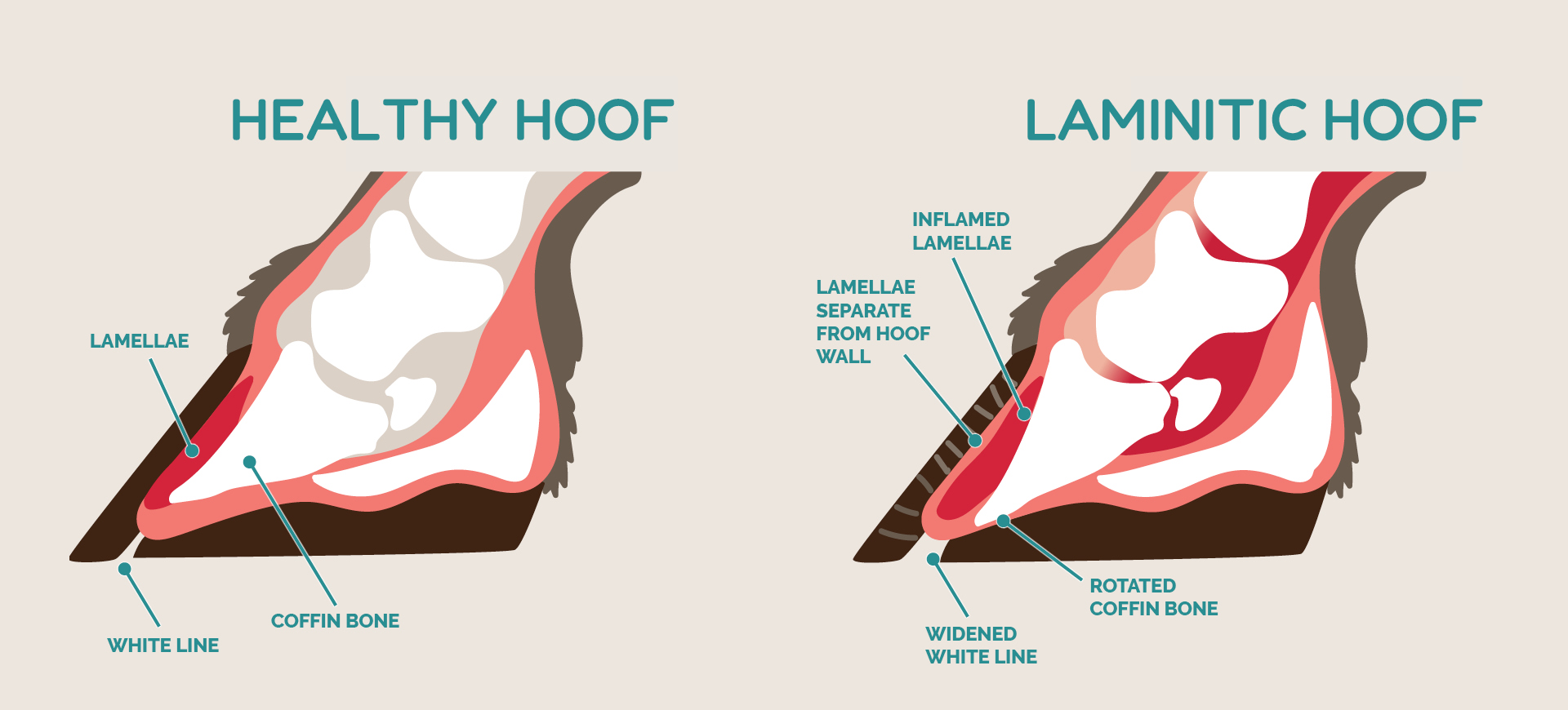
Clinical Signs:
- Characteristic “founder stance” with front feet positioned forward
- Reluctance to move
- Heat in the hooves
- Bounding digital pulse
- Depression and loss of appetite
Types:
- Acute laminitis: First few days before coffin bone displacement
- Subacute laminitis: Lasting longer than 3 days without bone displacement
- Chronic laminitis: Involves coffin bone displacement and permanent hoof changes
What it means: Laminitis is a medical emergency requiring immediate veterinary attention. Early intervention can prevent catastrophic coffin bone rotation and improve long-term prognosis.
3. Navicular Syndrome
Navicular syndrome is a chronic, degenerative condition affecting the navicular bone, bursa, and associated structures. It’s one of the most common causes of chronic forelimb lameness in athletic horses.

Clinical Signs:
- Gradual onset lameness that comes and goes
- Shortened stride length
- Stumbling tendency
- Worsening when turning in tight circles
- Often affects both front feet
Risk Factors:
- Certain breeds (Quarter Horses, Warmbloods, Thoroughbreds)
- Poor conformation
- Repetitive concussion
- Age (typically 8-10 years and older)
What it means: While navicular syndrome cannot be cured, it can often be managed successfully with proper shoeing, medication, and lifestyle modifications to extend the horse’s useful life.
4. Bruised Soles and Corns
Sole bruising occurs from direct trauma, often from stones, irregular ground, or poor shoeing practices.
Clinical Signs:
- Sudden onset lameness
- Positive reaction to hoof testers
- Visible bruising on the sole (may appear as red discoloration)
- Heat and sensitivity in the affected area
What it means: Most sole bruises heal well with rest and proper foot protection. However, they can progress to abscesses if not managed appropriately.
5. Tendon and Ligament Injuries
Injuries to the flexor tendons and suspensory ligament apparatus are common in athletic horses, particularly those in high-impact disciplines.
Common injuries include:
- Superficial digital flexor tendinitis
- Deep digital flexor tendinitis
- Suspensory ligament injuries
- Check ligament injuries
Clinical Signs:
- Swelling along the back of the leg
- Heat and pain on palpation
- Lameness that may worsen with exercise
- Possible visible “bow” in chronic cases
What it means: Tendon and ligament injuries require careful management and often extended rehabilitation periods. Early diagnosis and appropriate treatment protocols significantly improve outcomes.
The Veterinary Examination Process
Lameness Grading Scale
Veterinarians use a standardized grading system to assess lameness severity:
- Grade 0: Sound
- Grade 1: Lameness difficult to observe, inconsistent
- Grade 2: Lameness difficult to observe at walk/trot in straight line
- Grade 3: Lameness consistently observable at trot
- Grade 4: Obvious lameness at walk
- Grade 5: Non-weight bearing lameness
Diagnostic Approach
Our comprehensive lameness examination includes:
- History taking – Understanding the horse’s use, recent activities, and onset of lameness
- Visual examination – Observing the horse at rest and in motion
- Palpation – Checking for heat, swelling, and pain responses
- Hoof testing – Using hoof testers to localize foot pain
- Flexion tests – Stressing joints and soft tissues
- Diagnostic imaging – X-rays, ultrasound, or advanced imaging as needed
- Nerve blocks – Systematically numbing areas to isolate the pain source
Treatment Approaches and Prognosis
Conservative Management
Many front leg lameness conditions respond well to conservative treatment:
- Rest and controlled exercise
- Anti-inflammatory medications
- Corrective shoeing and trimming
- Physical therapy modalities
- Regenerative therapies (PRP, stem cells, shockwave)
Surgical Options
Some conditions may require surgical intervention:
- Deep digital flexor tenotomy for chronic laminitis
- Neurectomy for navicular syndrome
- Arthroscopic procedures for joint conditions
Prevention Strategies
Key prevention measures include:
- Regular hoof care – Consistent farriery every 6-8 weeks
- Proper nutrition – Avoiding grain overload and managing pasture access
- Appropriate conditioning – Gradual fitness programs
- Good footing – Avoiding excessively hard or irregular surfaces
- Body weight management – Maintaining ideal body condition
- Regular veterinary examinations – Early detection of problems
When to Call Your Veterinarian
Immediate veterinary attention is required for:
- Sudden onset severe lameness (Grade 4-5)
- Signs of laminitis (founder stance, heat in hooves)
- Non-weight bearing lameness
- Suspected fractures
- Signs of infection (fever, swelling, discharge)
Schedule routine examination for:
- Mild, intermittent lameness
- Changes in performance or movement
- Chronic conditions requiring monitoring
The Importance of Early Intervention
Early recognition and prompt veterinary intervention significantly improve outcomes for horses with front leg lameness. Many conditions that might become career-ending if left untreated can be successfully managed when caught early.
At Stride Vets, we emphasize the importance of regular lameness evaluations and maintaining open communication with horse owners about subtle changes in their horses’ movement and behavior.
Advanced Diagnostic Technologies
Modern veterinary practice offers sophisticated diagnostic tools:
- Digital radiography for immediate, high-quality imaging
- Ultrasound for soft tissue evaluation
- MRI and CT for complex cases
- Nuclear scintigraphy for detecting stress injuries
- Force plate analysis for objective lameness measurement
Conclusion
Front leg lameness represents one of the most significant challenges in equine health, but with proper understanding, early recognition, and appropriate veterinary care, many horses can return to full function. The key lies in recognizing the early warning signs, seeking prompt veterinary evaluation, and following through with comprehensive treatment plans.
Remember that every horse and every lameness case is unique. What works for one horse may not be appropriate for another, which is why professional veterinary evaluation is essential for accurate diagnosis and effective treatment planning.
At Stride Vets, we’re committed to providing the highest standard of equine lameness evaluation and treatment. If you notice any changes in your horse’s movement or behavior, don’t hesitate to contact us for a comprehensive evaluation.
Sources:
- Merck Veterinary Manual – Overview of Lameness in Horses
- Horse Side Vet Guide – Lameness Recent Front Limb
- Merck Veterinary Manual – Disorders of the Foot in Horses
For professional veterinary consultation regarding front leg lameness, contact Stride Vets at stride-vets.co.uk. Our experienced team provides comprehensive lameness evaluation and treatment services throughout our service area.

